About Ebykr
Ebykr celebrates classic and vintage lightweight bicycles through provoking imagery and opinion. Let's roll together!
About Ebykr
Ebykr celebrates classic and vintage lightweight bicycles through provoking imagery and opinion. Let's roll together!
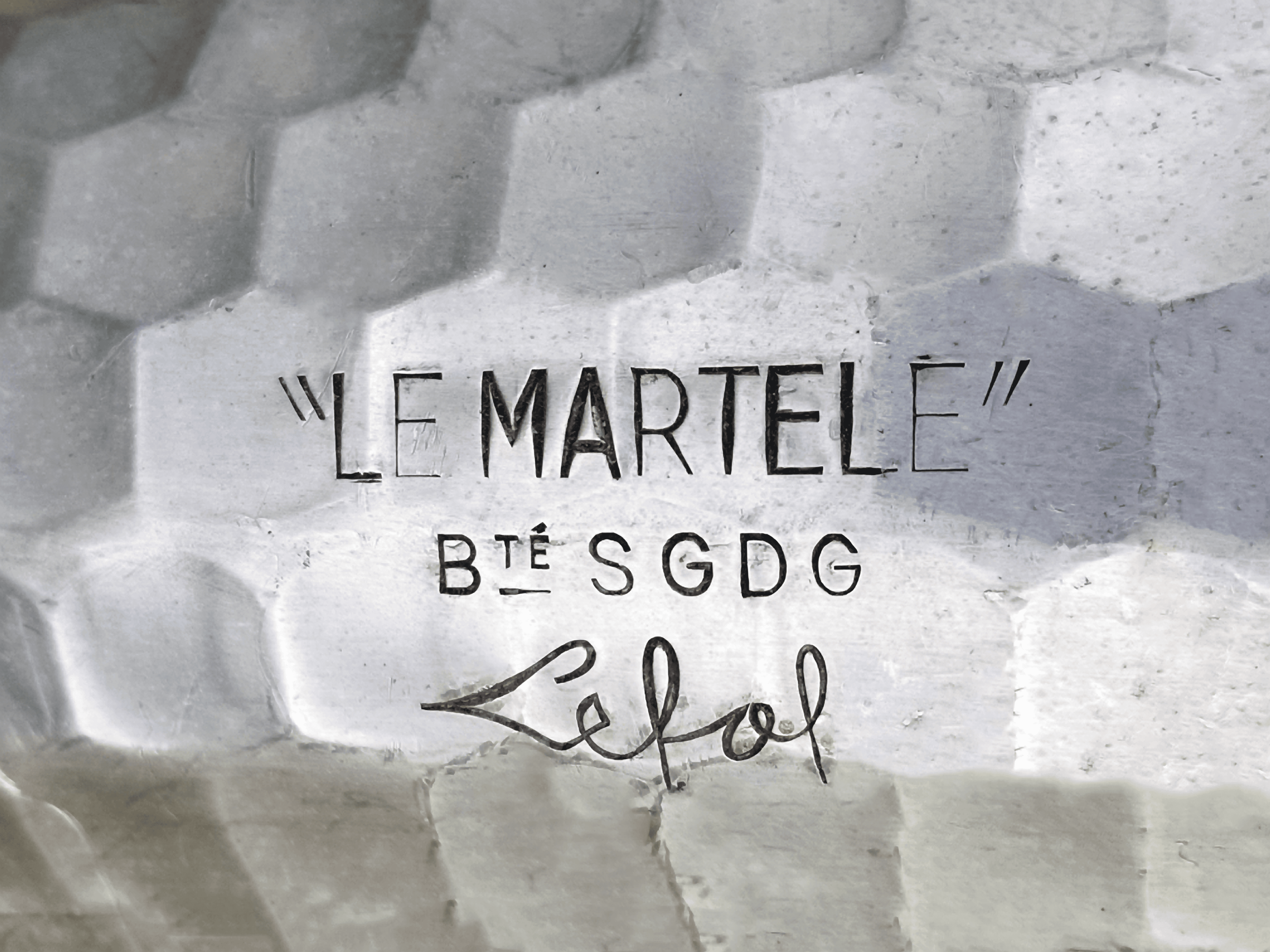
As with other French component makers from cycling’s golden era that remain popular today – Ideale, JOS, Maxi-Car and Stronglight, to name a few – surprisingly little is known about the Lefol marque given the timeless familiarity of the company’s fenders. Maybe aluminum just rusts slower than steel, with oxidation resistance preserving Lefol’s legacy more than resilience of character or strong will, or maybe there’s something more to it.
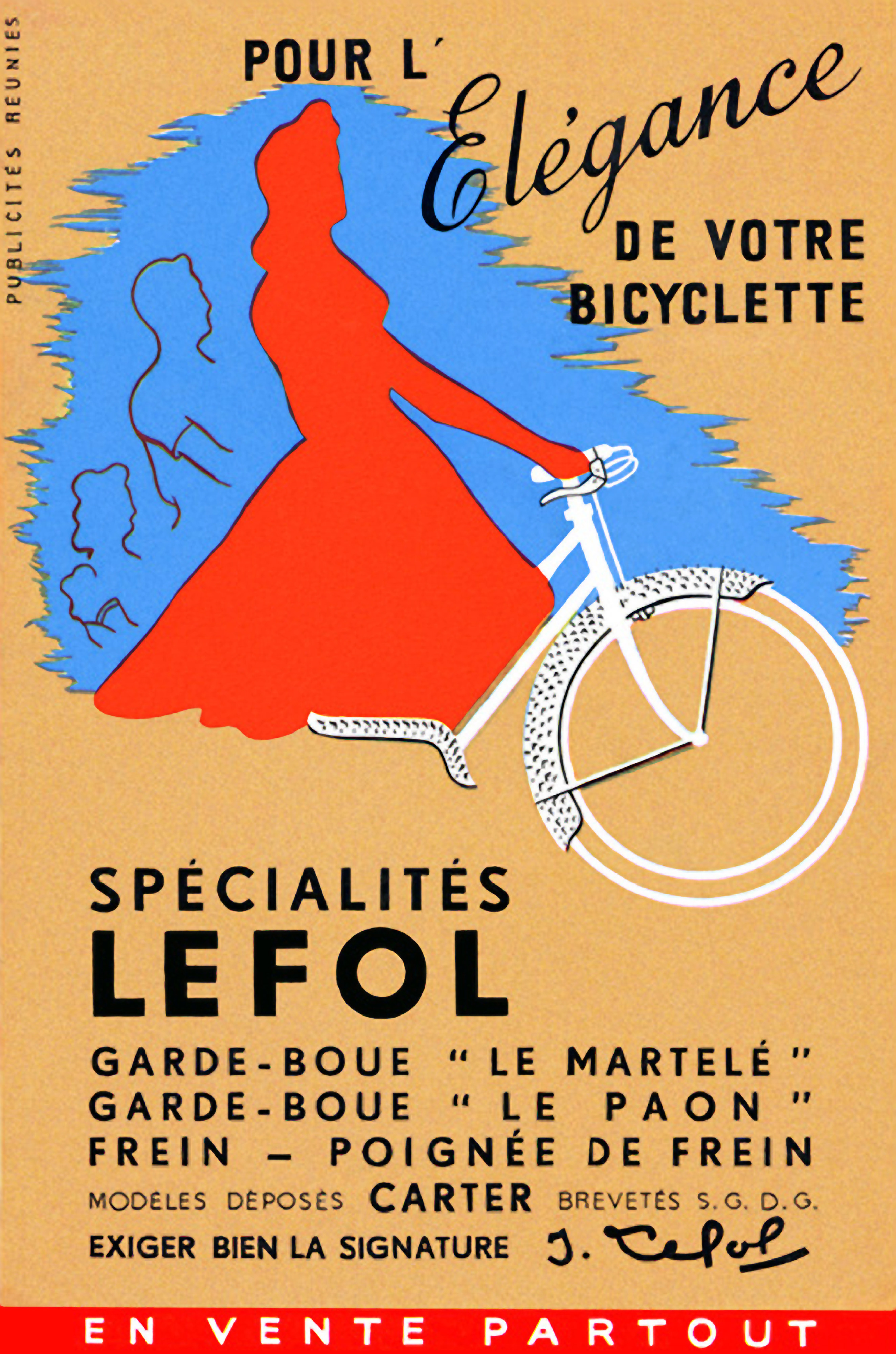
Historical accounts suggest there’s more to it, but just how much is hard to tell. Here goes anyway: Courbevoie is a progressive commune of 87,000 residents located about 2km from the outer limits of central Paris, which means 8km from what most people would consider the real center of Paris. The Courbevoie commune plays centrally in the Lefol family story for one or maybe two generations.
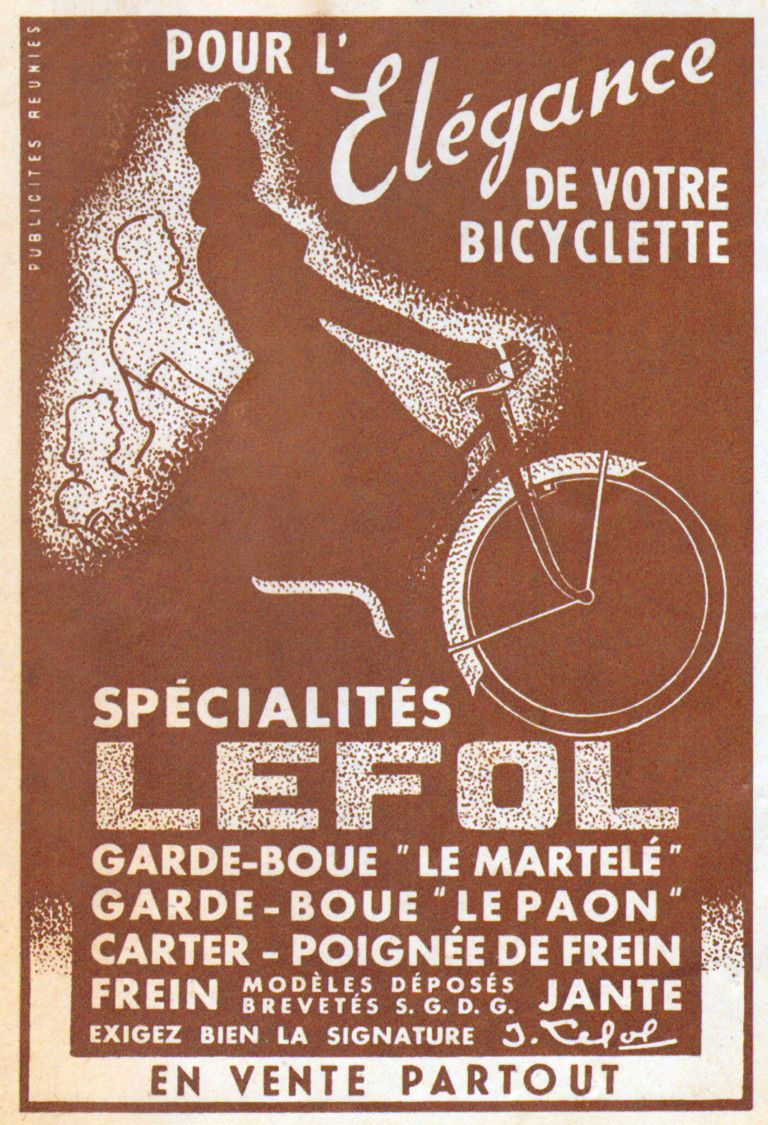
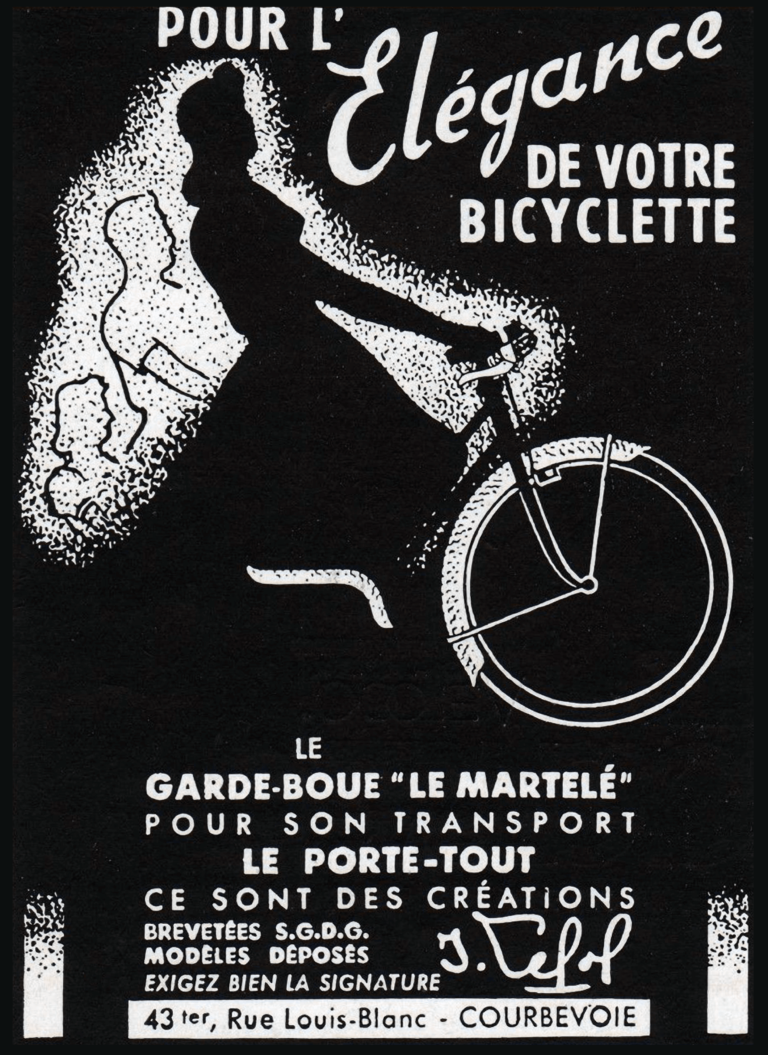
Communes are a level of administrative division in the French Republic, roughly equivalent to civil townships in the United States. They vary in size from tiny to huge (under 10,000 to 2.2 million) but many somehow remain the most desirable places to live in France. Courbevoie ranks as the third-best place to live in the Île-de-France region, after the neighboring communes of Levallois-Perret and Neuilly-sur-Seine.
Incidentally, Levallois-Perret is home to the glorious Cycles Alex Singer, constructeur of among the finest bicycles in the world for over sixty years, while Neuilly-sur-Seine is home to the comparatively inglorious JCDecaux Group, dominant outdoor advertiser and purveyor of Cyclocity. Perhaps it’s all a matter of perspective.
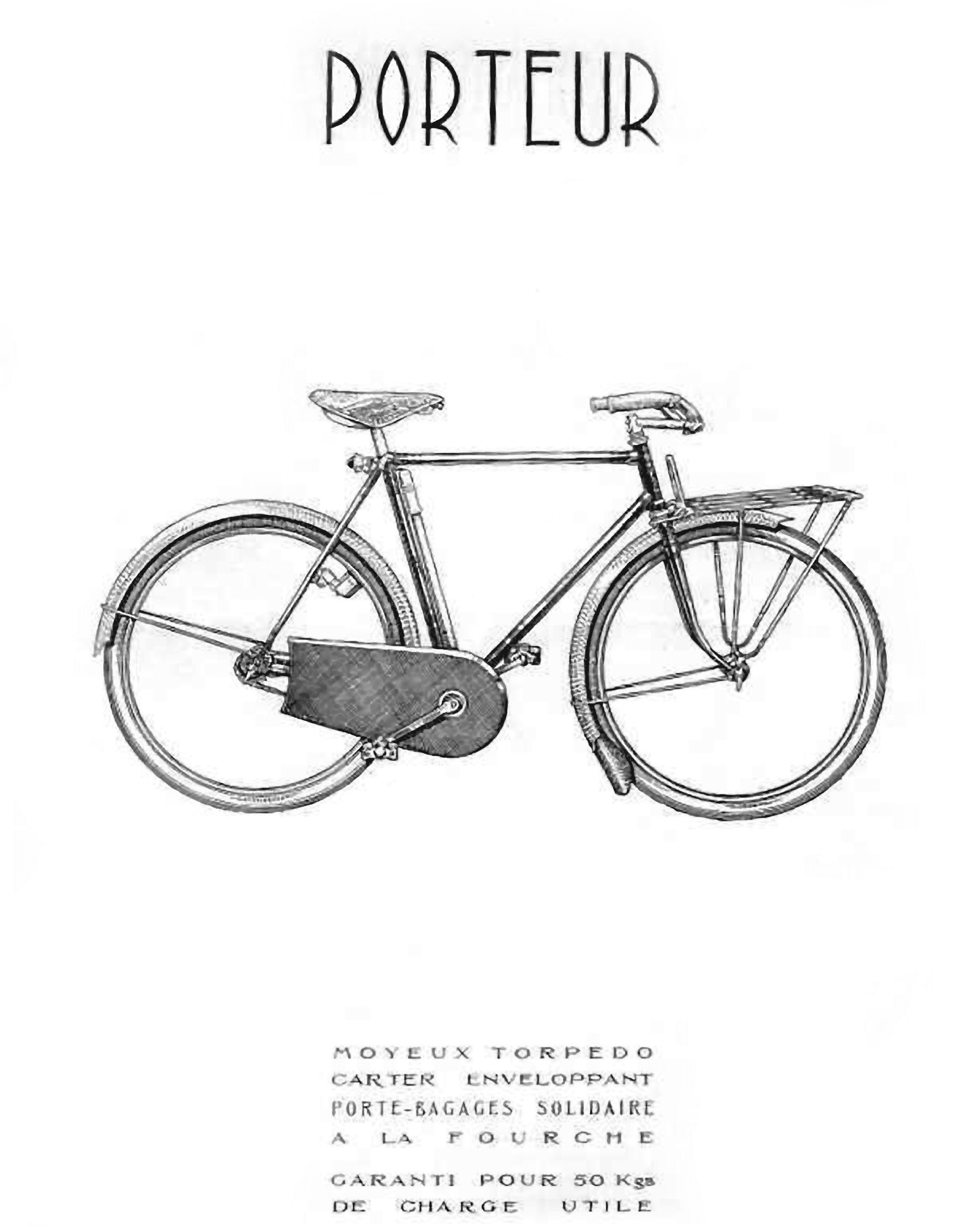
Cyclocity is the parent brand of one of the largest providers of public bicycle rental systems in the world, with over 50,000 bicycles circulating across 29 cities in Asia and Europe. Each installation is financed by local advertising operators in return for the cities signing over ten year licenses to exploit city-wide billboards. (Faust was said to have devised the scheme while riding tandem with the devil himself).
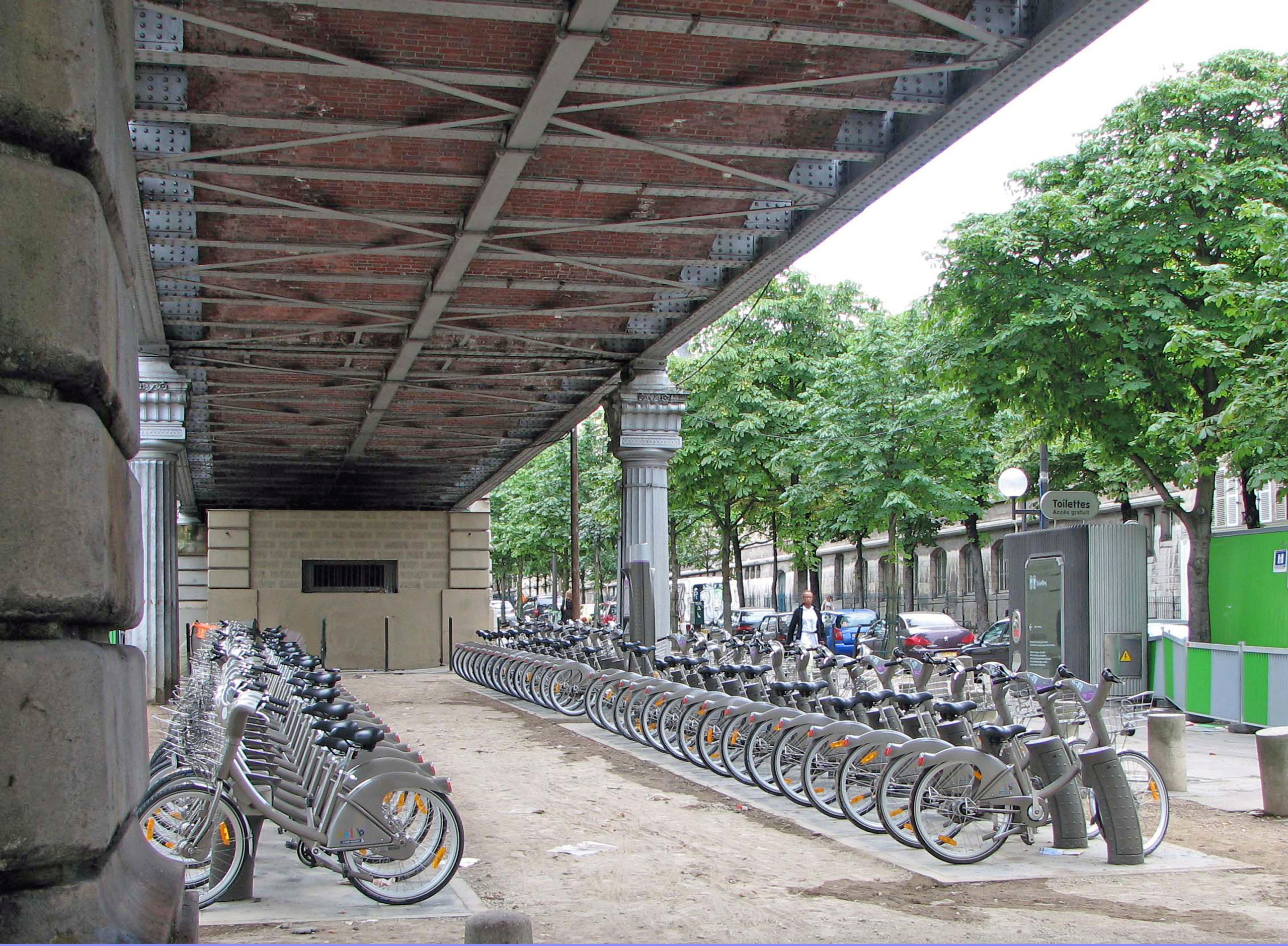
(Wikimedia Commons/TCY)
Lefol Cie — makers of those durable and elegant aluminum fenders that somehow never seem to die or go out of style — were located at 49 Rue d’Alsace and then 43 Rue Louis-Blanc in Courbevoie from around 1947 through at least 1961. Before that, they were located in the 11th Arr. of Paris at 48 Boulevard Voltaire from at least 1936 until they moved to Courbevoie around 1945 when World War Two ended. While some historical details about Lefol Cie remain inexact, these locations and dates are confirmed by company catalog references and magazine advertisements.
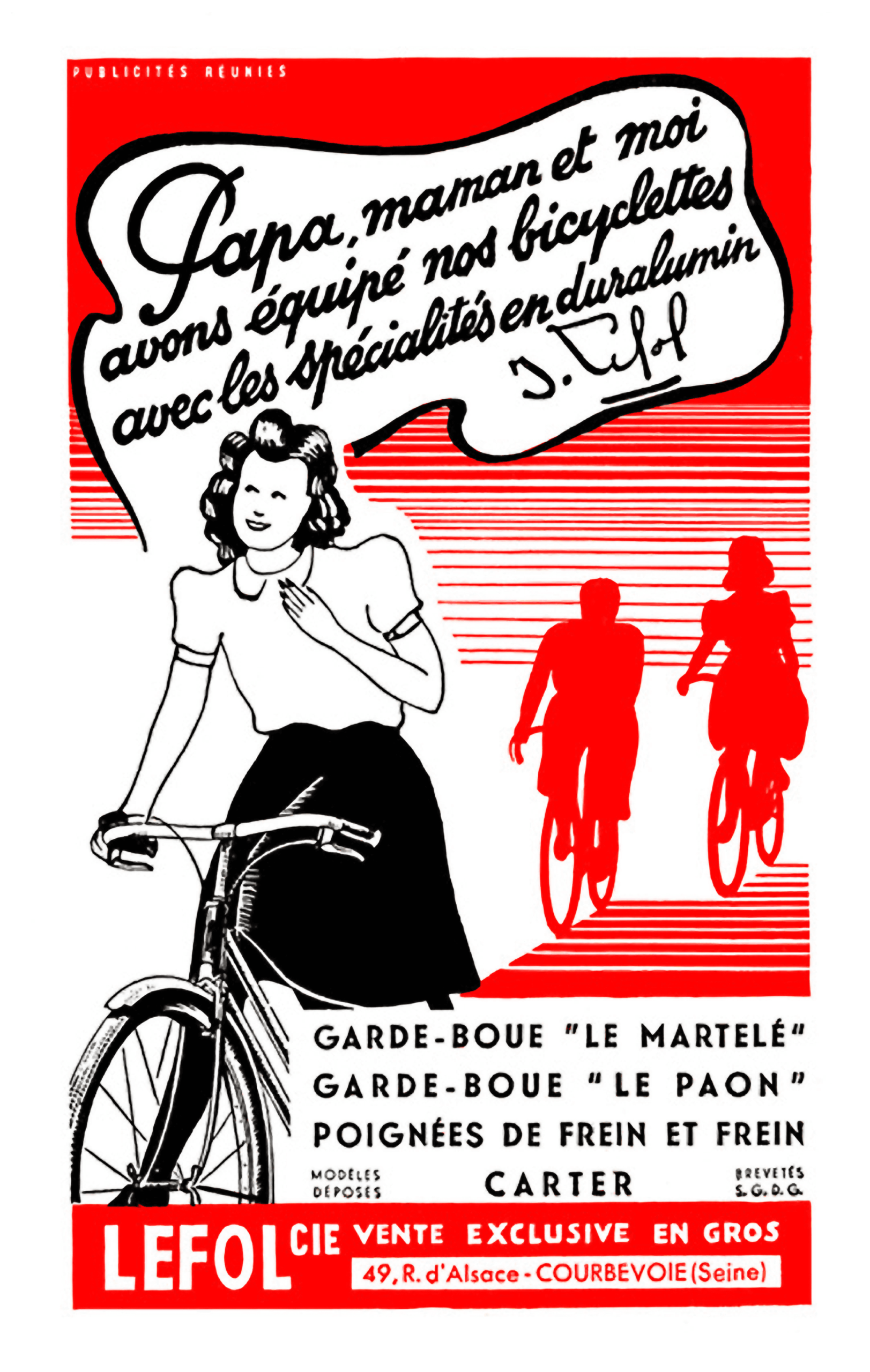
The first known cross reference of “J. Lefol” and “Courbevoie” goes all the way back to 1871. In it, one J. Lefol is co-signator to a letter that foreshadows the French Revolution by seeking to revive the courage of Courbevoie’s defenders and strike terror among still-hidden traitors from Versaille. With the monarchy’s military command misaligned with Courbevoie’s municipal needs and wants, the stage was set to resolve this core philosophical dispute through armed, even existential conflict. Not exactly the stuff of bicycles or their components.
Lefol’s letter was published by “L’association des Défenseurs de la République” in the third such volume of works investigating the insurrection of March 18, 1871 by the National Assembly in Versaille. It was signed rather unambiguously, “Vive la Commune! Long live the democratic and social Republic!” Strong words coming from someone with strong convictions. So, what does all this revolutionary talk have to do with fancy bike fenders? A lot, it would seem.
You see, the date of March 18, 1871 is also when the Paris Commune was first established. While many outsiders were appalled when “grossly ignorant” laborers and “schemers and visionaries” took over the French capital, the day’s events would forever reshape the people and politics and products of France.
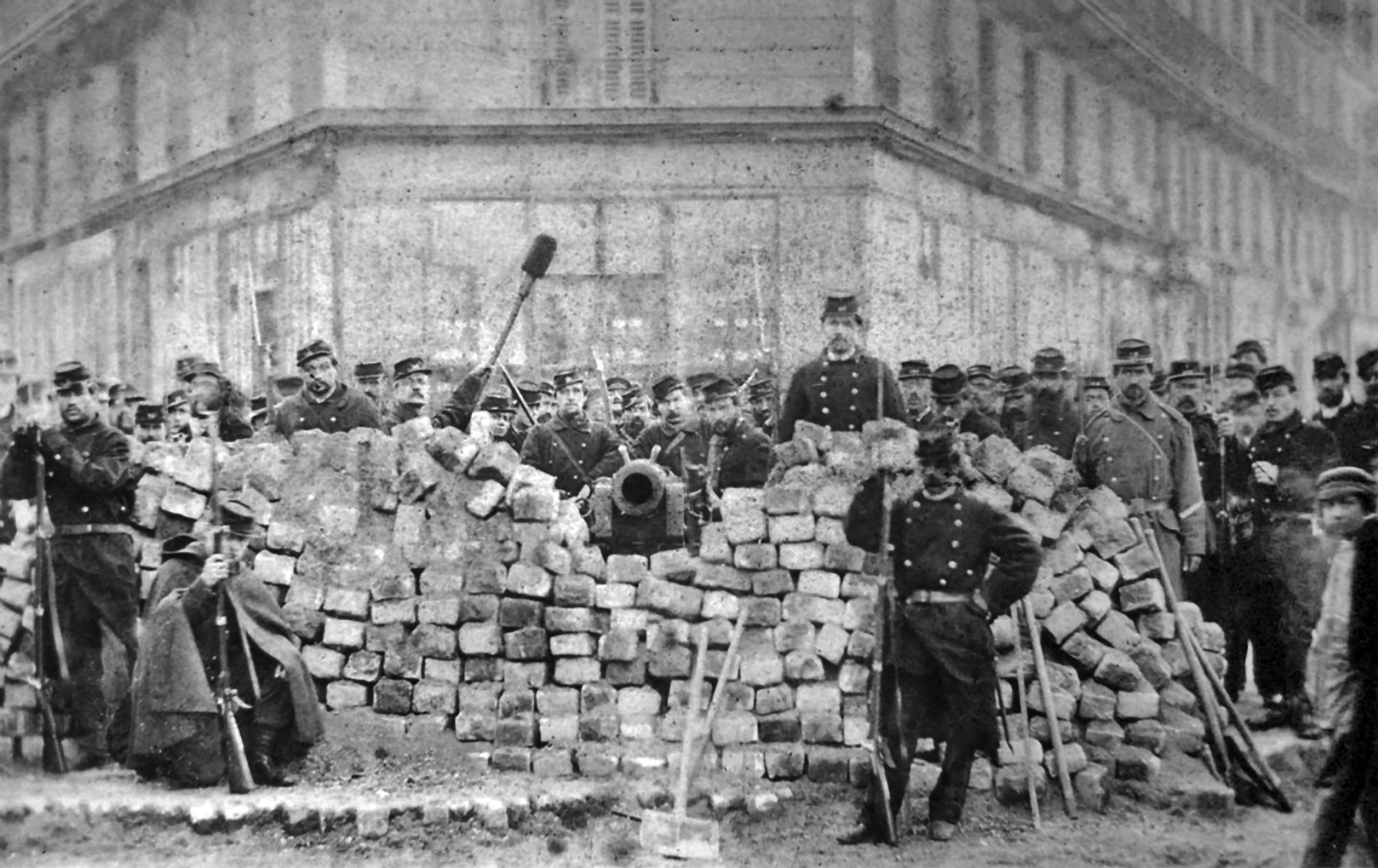
(Wikimedia Commons/Bruno Braquehais)
Indeed, it would take three more decades for the French Revolution to fully expunge the country’s monarchy and set the stage for Napolean’s rise to defacto ruler of Western Europe. But the wheels of change were already gaining momentum, as they like saying at the Gran Fondo.
Sixty five transformational years later, one Jacques François Lefol would be hawking his now-infamous Le Martelé fenders on Boulevard Voltaire. The Boulevard is a central axis joining two historical squares associated with the French revolution — the Place de la République and Place de la Nation — that remains a main hub for entertainment stores and left-wing demonstrations alike. Where better a location to cater to the needs of proletariat cyclists and their everyday needs during cycling’s heyday?
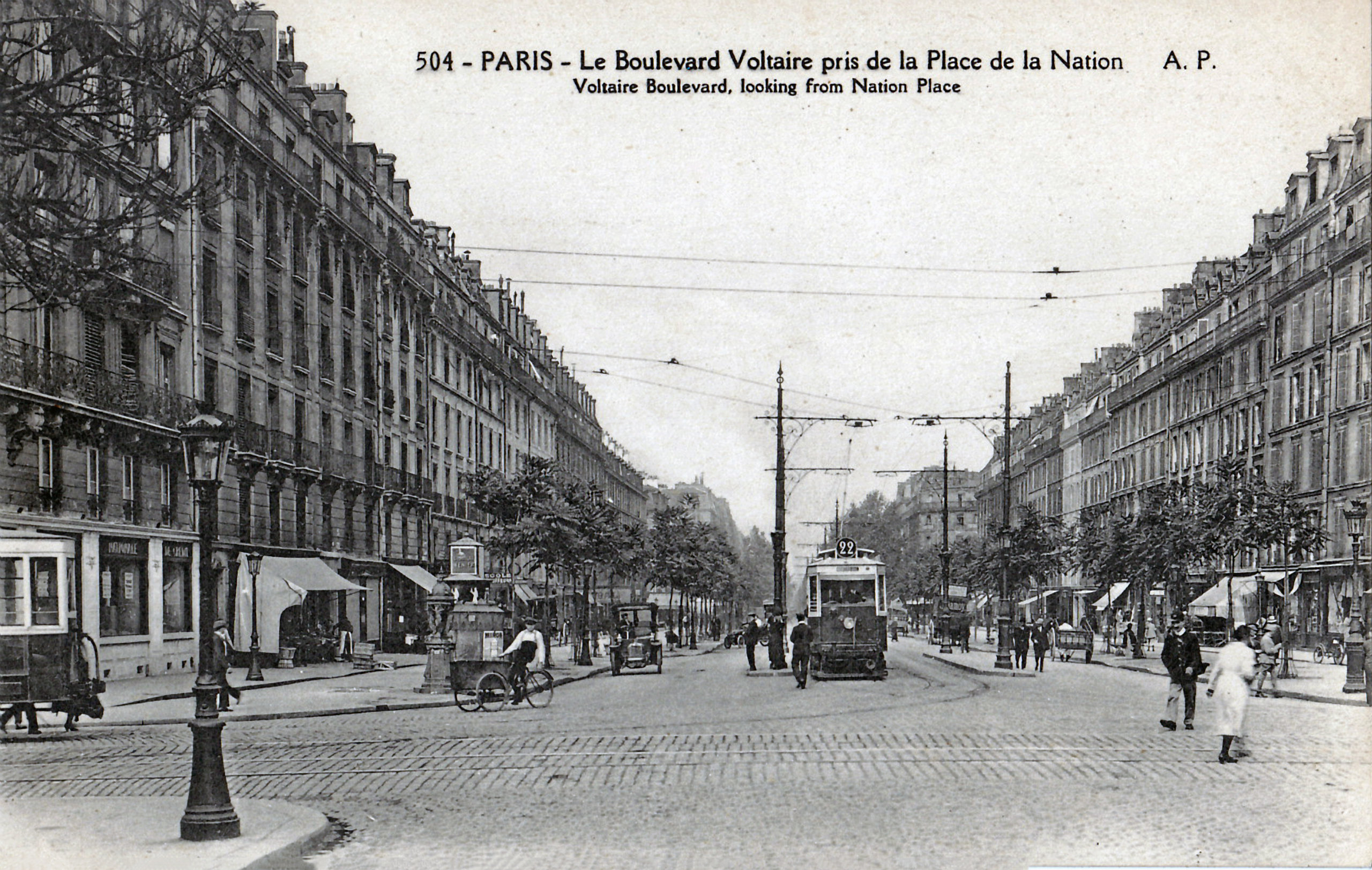
Known Lefol advertisements predate known Lefol catalog entries by three years. The first Lefol advertisement appeared in none other than Le Cycliste magazine in the venerable rag’s April 1936 edition. Le Cycliste was Paul de Vivie’s publication, with de Vivie – who wrote as Vélocio – widely regarded as the “father” of French cyclotouring and randonneuring. The ad featured “Le Garde-Boue Martelé” fenders with “à plate-forme Emboutie,” or small shelf “pressed to platform.” Interested parties need only dial “69” to purchase a pair from “J. Lefol – Inventeur – Constructeur.” How elegantly simple.
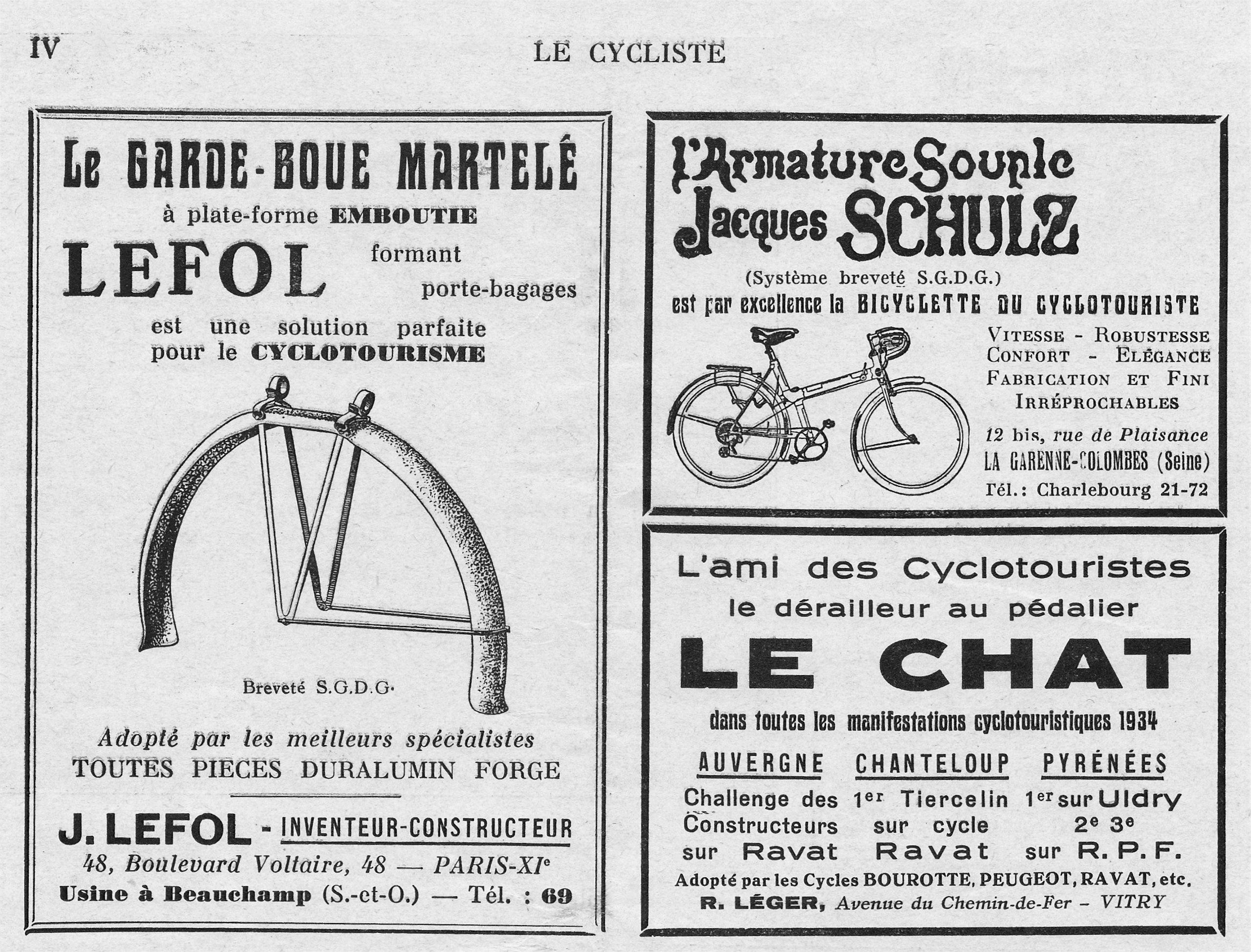
Lefol Le Martelé fenders and variations thereof became more widely available over the next three years. Entries in the Gentil and Mestre et Blage catalogs from 1939 have Lefol offering his trademark fender design in varying widths with or without a platform or rear light. As one might guess, the wider “demi-ballon” model with platform, light and duralumin hardware commanded the highest price point at 86 francs a pair. Narrower “course” models without platform or rear light could be purchased for 52 francs.
It is notable how no other aluminum fenders were widely available in pre-World War Two France. Despite the obvious popularity of cycling then and there, Lefol appeared to have an effective monopoly on lightweight, metal fenders. Other French fender manufacturers like HD Darnault and Nervurex were producing thick steel models for demi-ballon and porteur bicycles, and the blokes across the Channel were busy producing their plastic Bluemels models for fancy British bikes, but Lefol was the only one to have been pushing the aluminum direction.
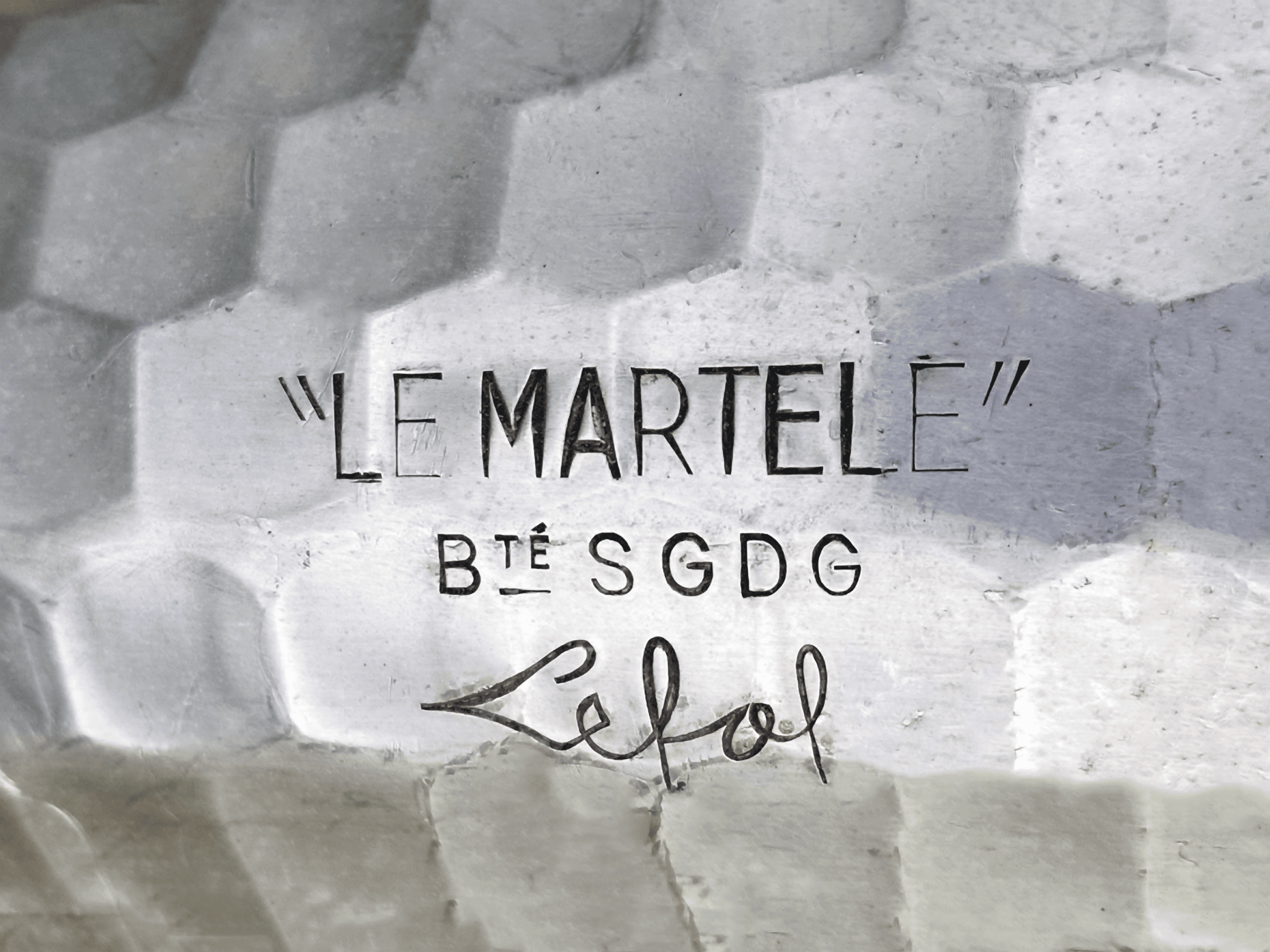
And for good reason. After World War Two, single-purpose manufacturers of steel fenders started falling from the marketplace while Lefol’s products rose to their greatest historical significance. Lefol caliper brakes, cantilever brakes, brake levers, chain guards and fenders were all available by 1947, and the stylish “Le Paon” model had been introduced alongside the hammered, familiar Le Martelé model.
Post-war Lefol was a different thing than pre-war Lefol. The name “J. Lefol” was now qualified with “ce sont des créations” in company marketing literature and their products were attributed to “Lefol & Cie” or just “Lefol Cie.” More importantly, company headquarters was relocated from downtown Paris to nearby Courbevoie. This change in location can be attributed to many things and interpreted in many ways.
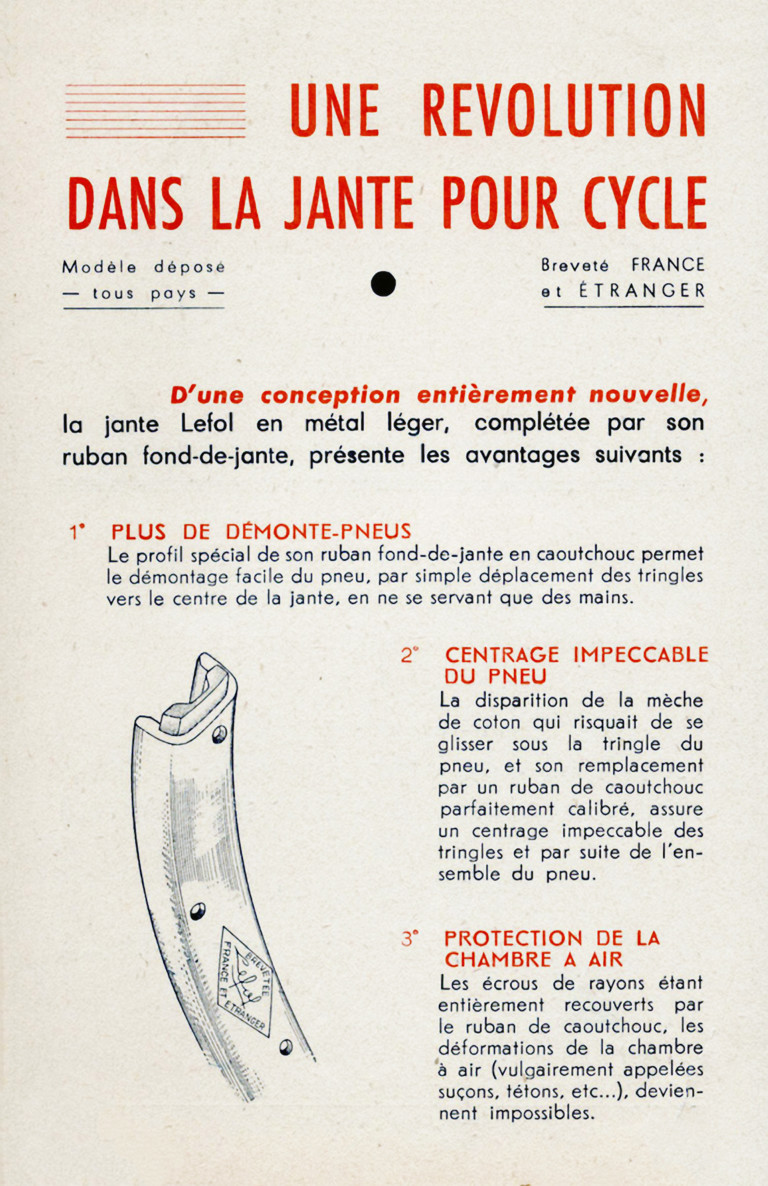
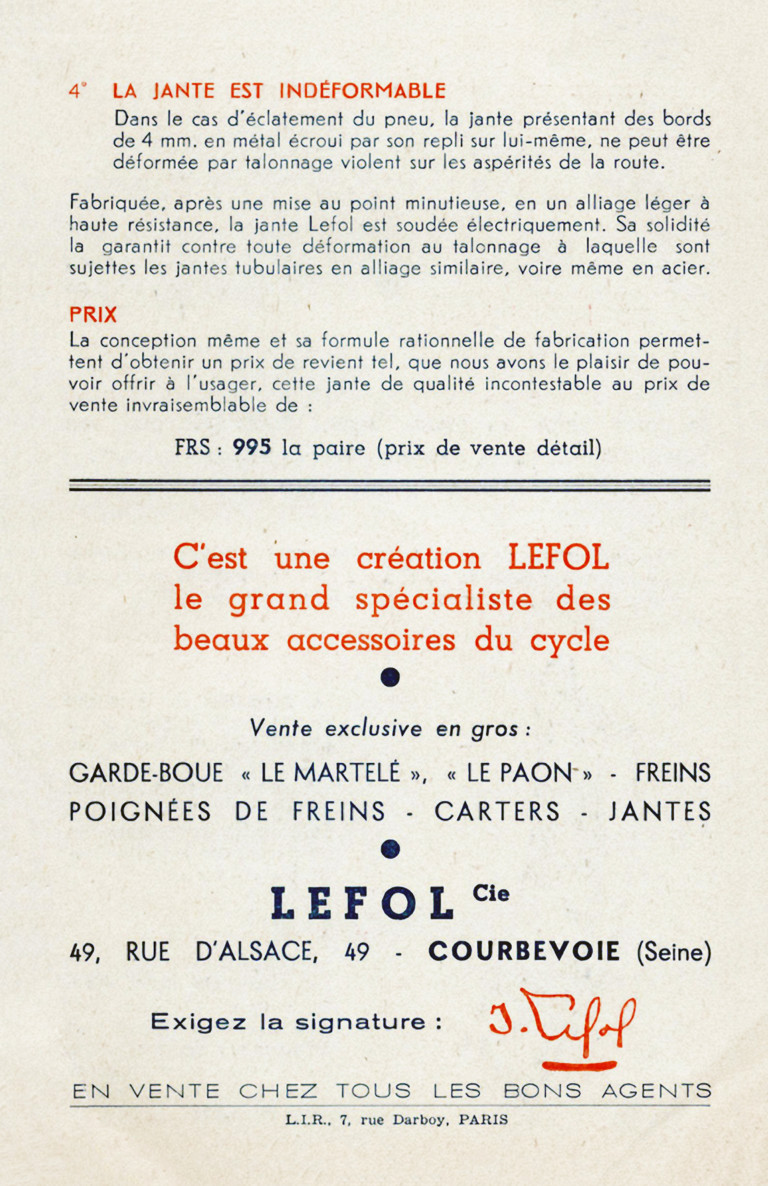
Exactly when it occurred remains unknown, though one can speculate it had something to do with a younger J. Lefol returning to where his namesake father came from. Either that, or an older J. Lefol returned home seventy six years after signing that pro-Republic letter back in 1871. Or maybe it’s just a coincidence that two people named J. Lefol were associated with Courbevoie as described. Hopefully time will better inform this part of the story.
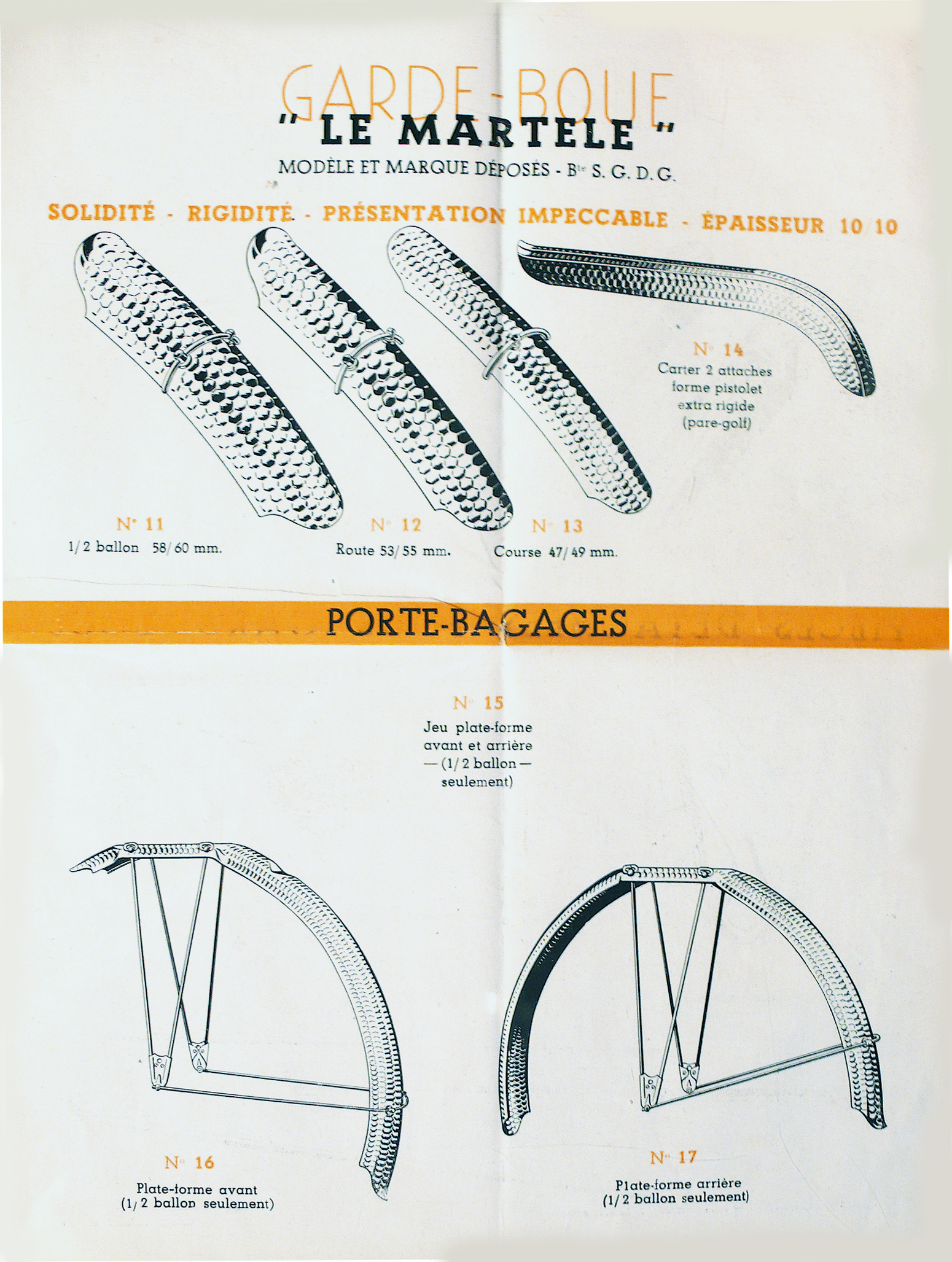
One thing is for sure: Lefol products were proliferate. Their 1950 catalog included the Le Martelé model fender range, with the no. 11 “demi-ballon” (650b, 58/60 mm), no. 12 “route” (700c, 53/55 mm), no. 13 “course” (700c, 47/49 mm) and “enfants” (400/450/500/550/600 wheels), no. 15 “plate-forme” (pair w/ front and rear platforms), no. 16 front platform and no. 17 rear platform variations, with nos. 15-17 available only in “demi-ballon” or 650b size.
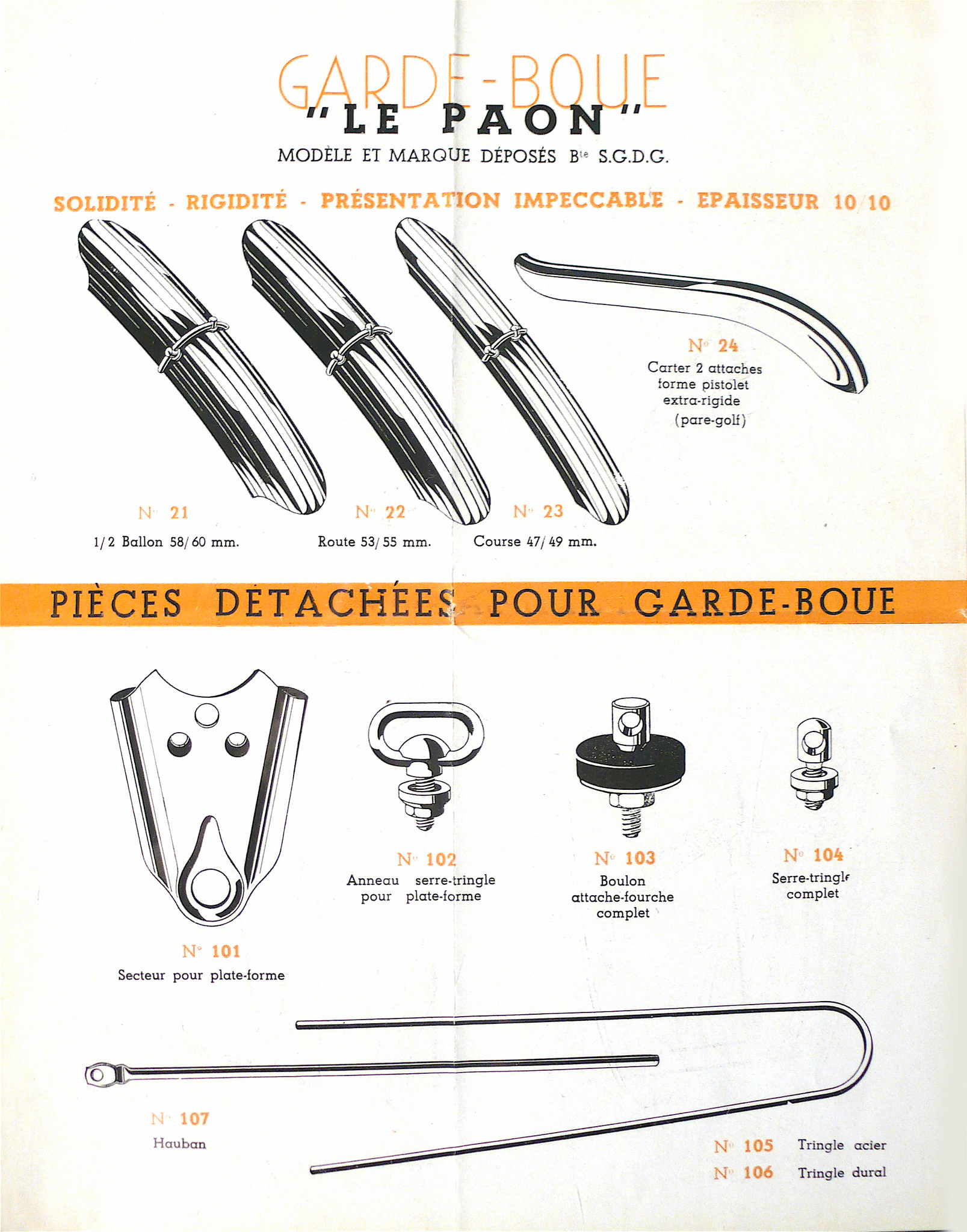
They also included “Le Paon” model fenders in no. 21 “demi-ballon” (650b, 58/60 mm), no. 22 “route” (700c, 53/55 mm) and no. 23 “course” (700c, 47/49 mm) variations. The “Le Pratique” model fenders seem to have been introduced after 1950 in both “course” and “demi-ballon” variations.
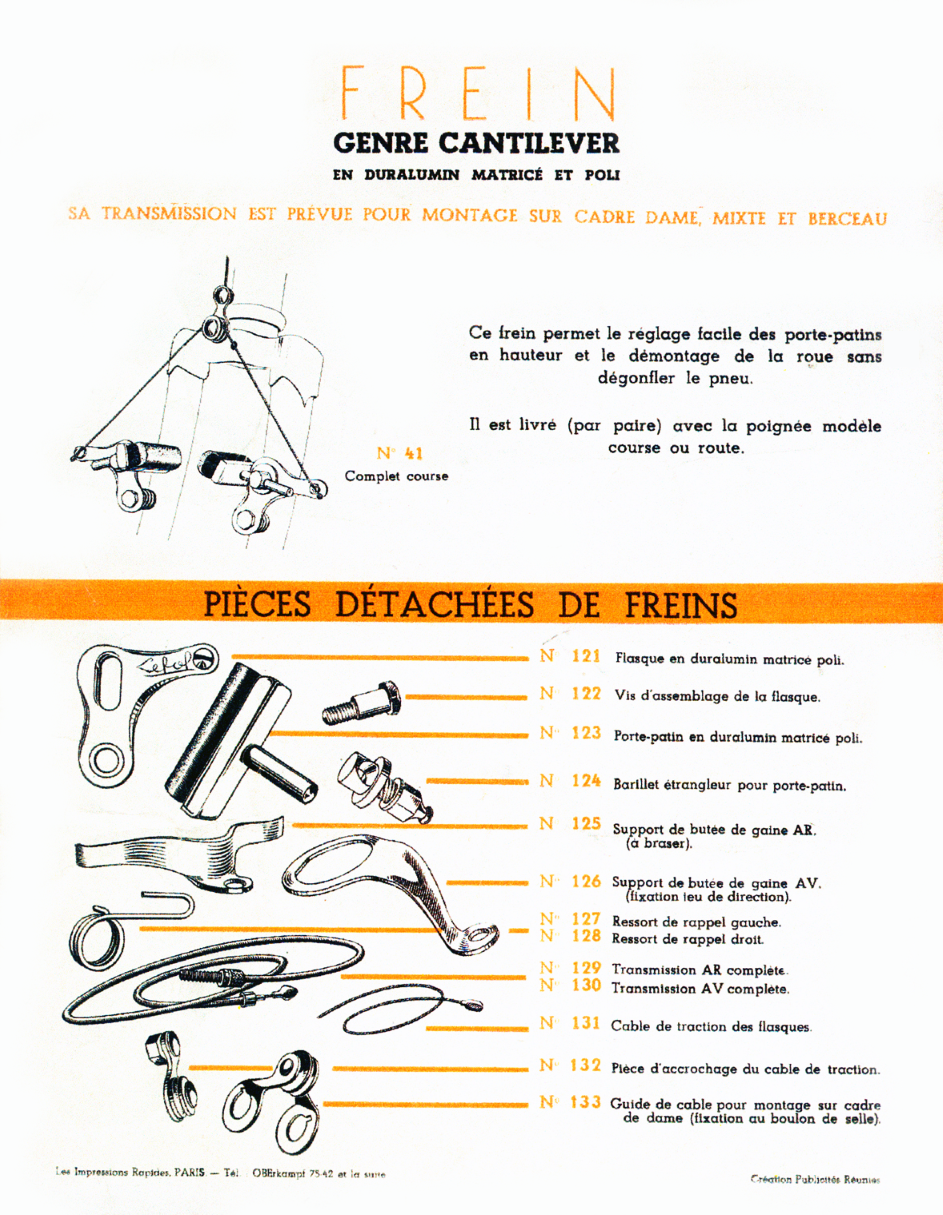
“Carter” or chain guard options included the no. 14 “Le Martelé” and no. 24 “Le Paon” models. Brake levers included the no. 31 “course” lever and no. 32 “route” lever, with both models sold in left and right hand pairs. Brakes themselves included the no. 41 cantilever-style model and a rarer model from 1946 that represents something of a hybridized cantilever/caliper style.
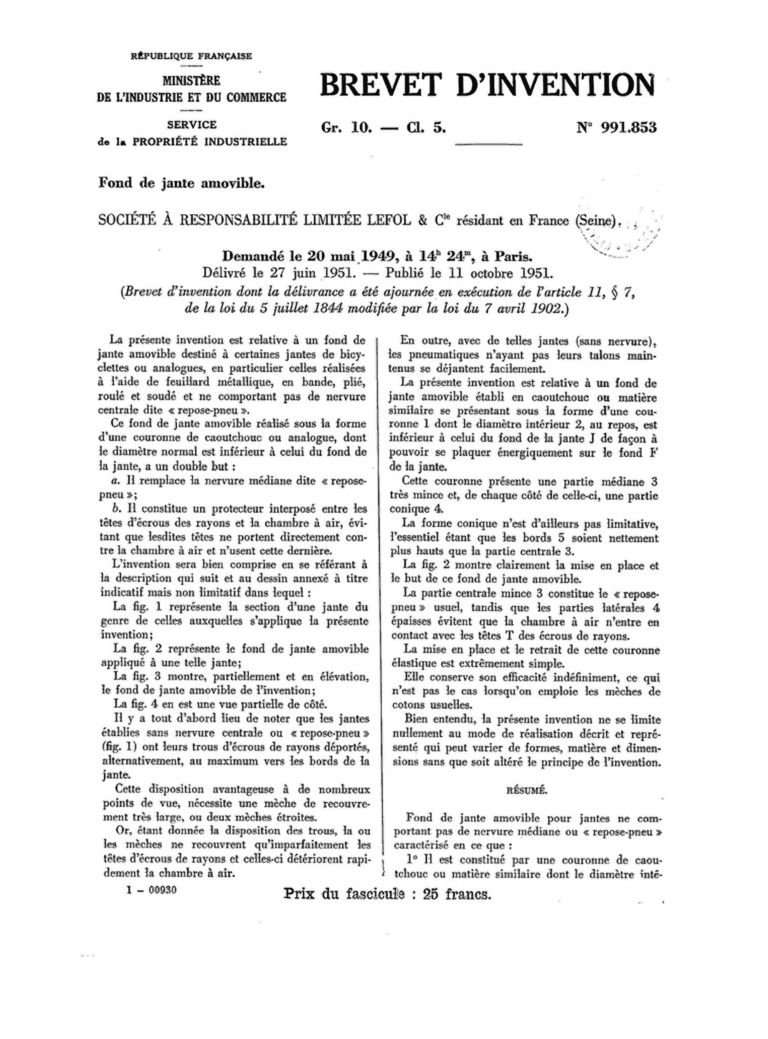
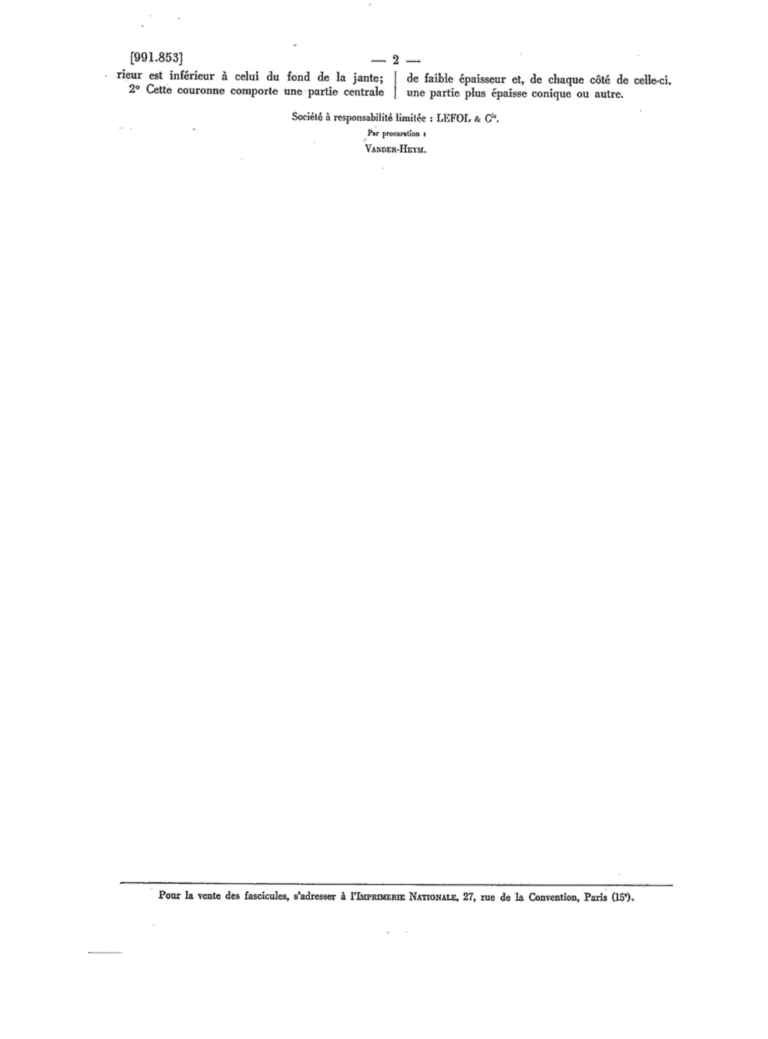
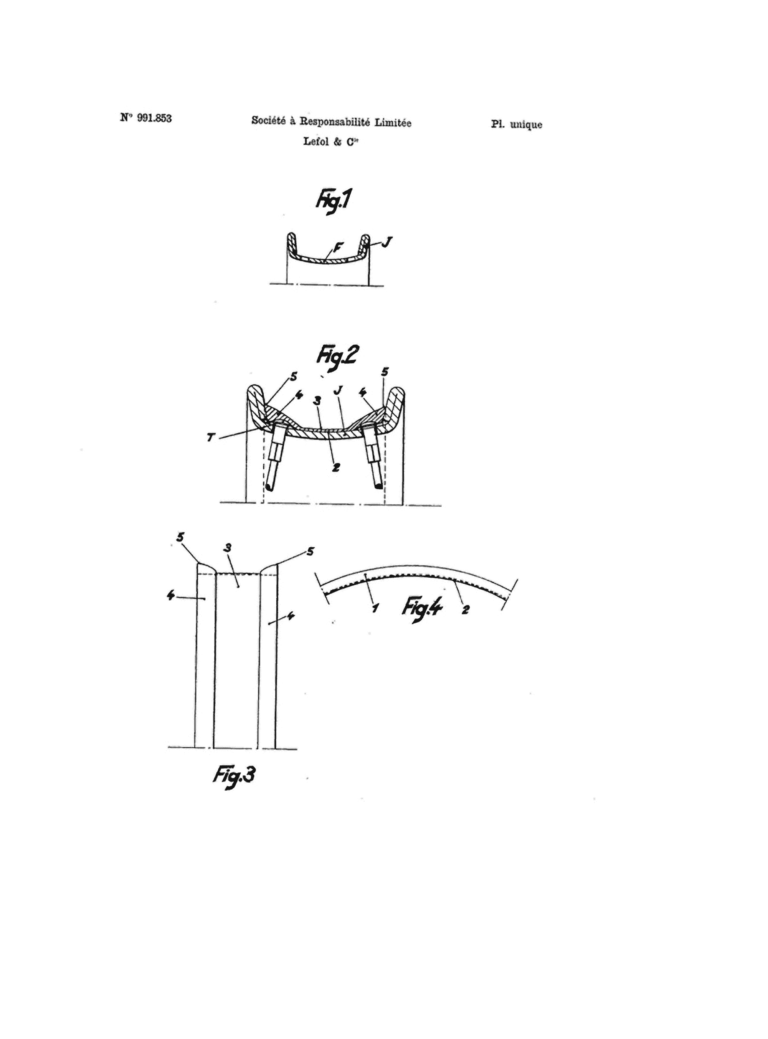
As mentioned, Le Pratique fenders nor rims are shown in the company’s 1950 catalog, and when they were introduced remains unknown. Lefol & Cie patented another innovative, lightweight rim design in May 1949, though this design did not seem to enjoy widespread manufacture.
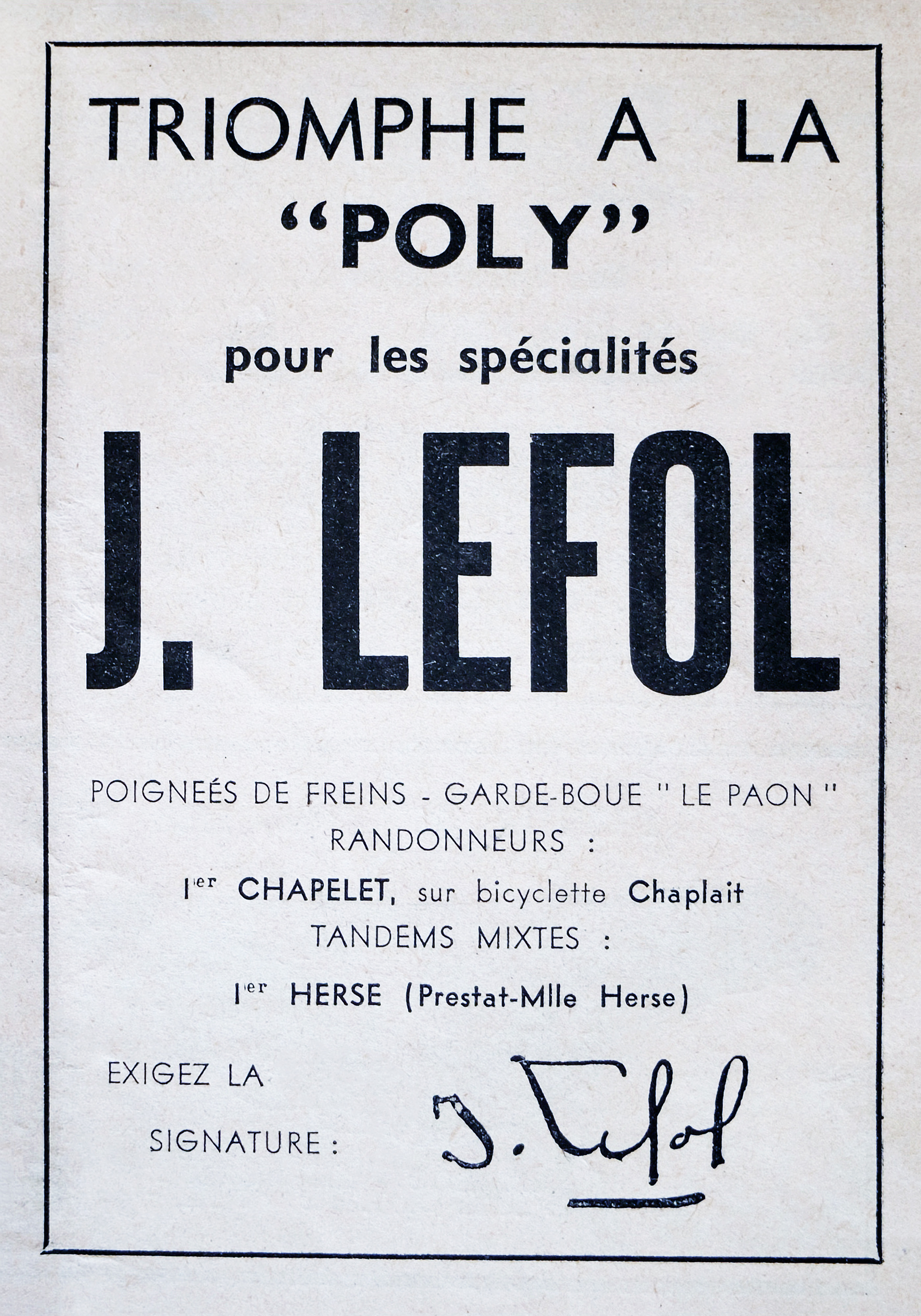
The Lefol brand appears to have apexed in the 1950s. The “J. Lefol” signature still had marketing value in 1961, though, when the Lefol Cie company proclaimed, “exigez bien la signature” or “demand the signature,” in a striking black and white magazine advertisement that harkened back to the art deco era of the 1920s and 1930s. Twenty five years on and the Lefol marque was still firmly grounded in the past, for better or worse. At least they tried selling automobile bumpers and even roof racks for boats.
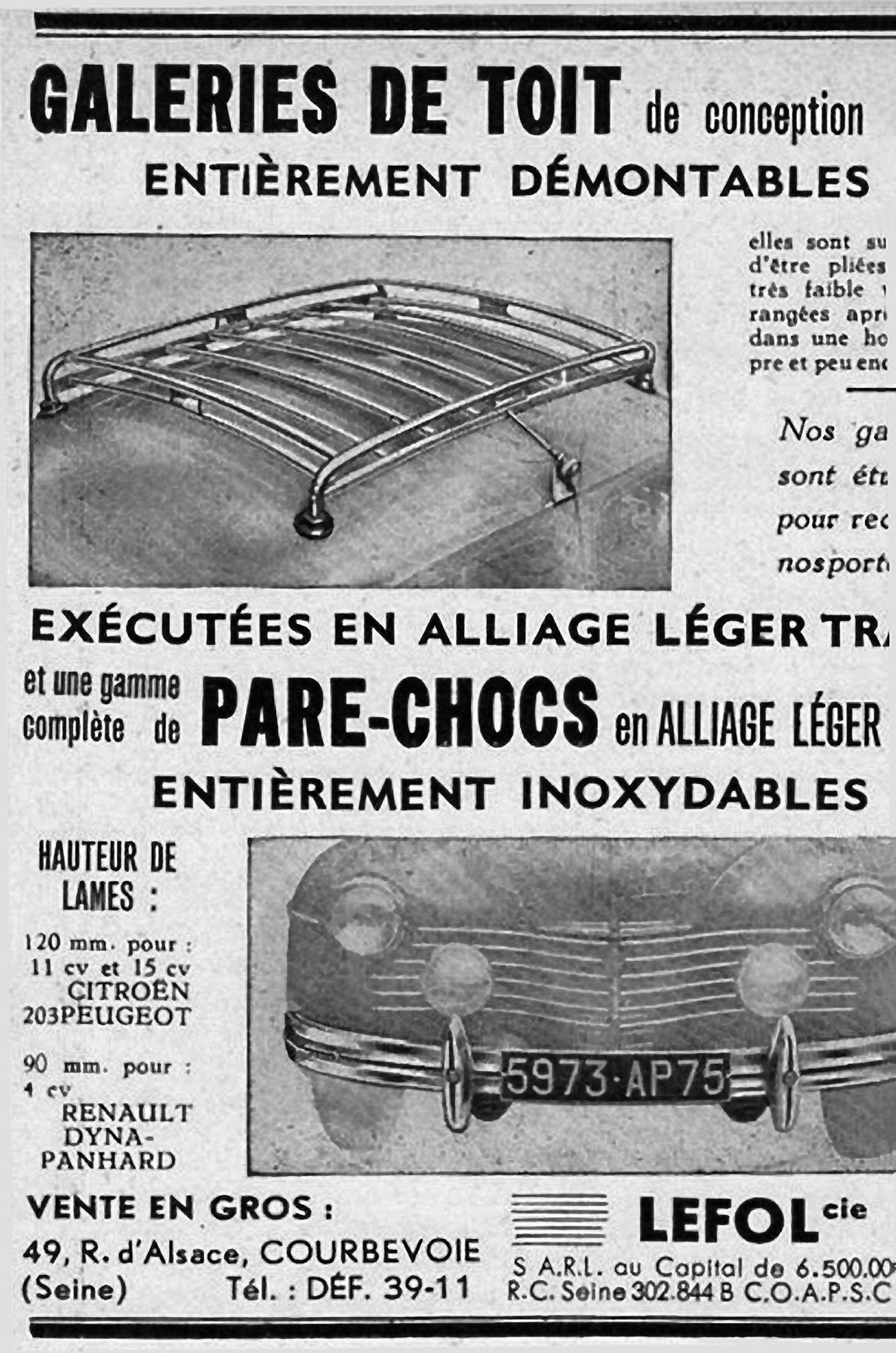
Until proven otherwise, we choose to assume the most romantic interpretation of the “J. Lefol” and “Courbevoie” connection – that which suggests a progressive-minded man who was pissed off with the monarchy and revolted by helping form a more representative French Republic, and then his native son coming back years later and helping revitalize his hometown after World War Two and bring it decades of economic prosperity and regional significance. Life’s too short not to remain an optimist. Perhaps the 70-year-young Lefol fenders on my daily rider are testament to the enduring power of this outlook.
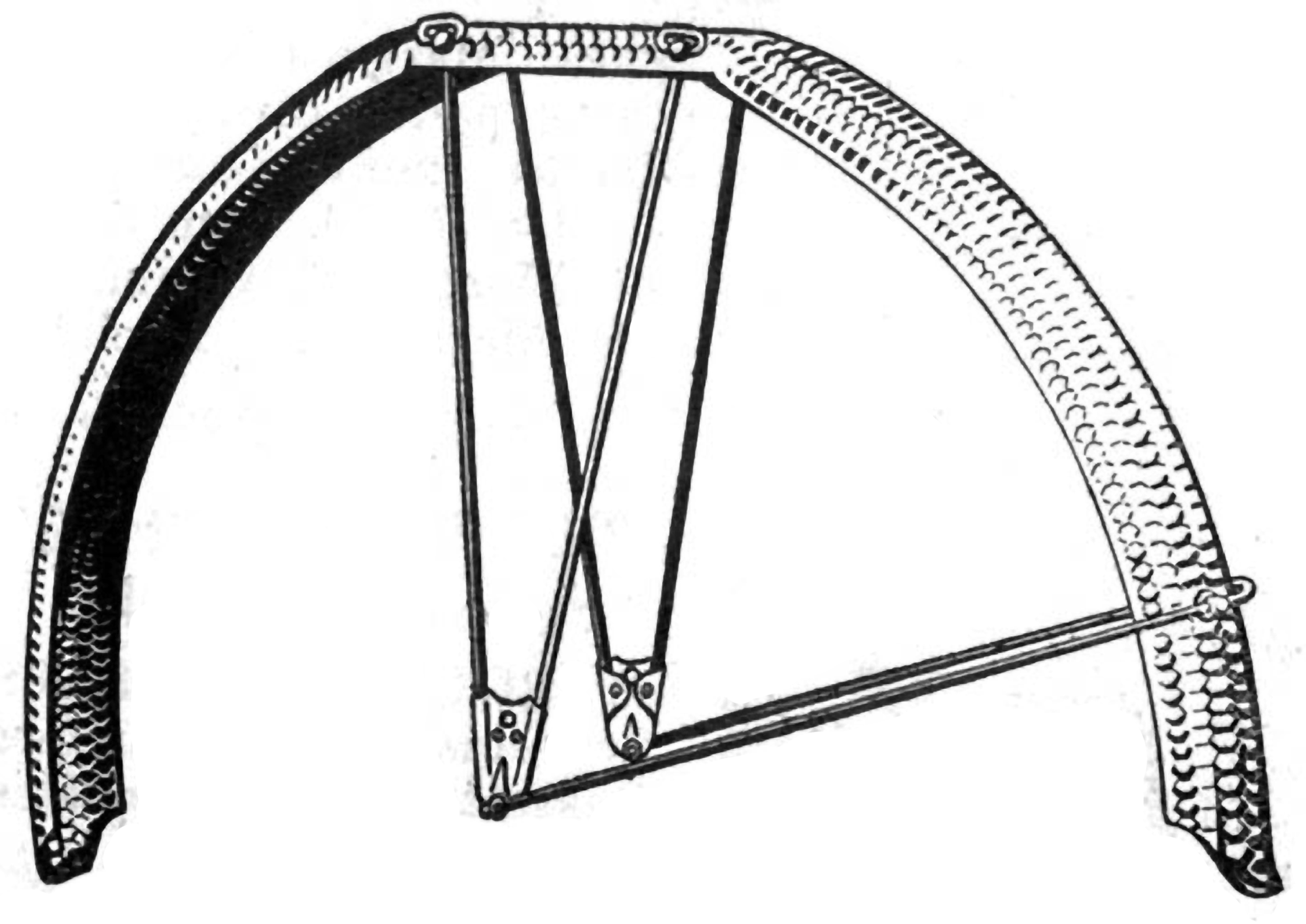
(In the interest of disclosure, nothing in Lefol or Lefol-related company or product literature tells the full Jacques François Lefol story. A fair amount of research was conducted while writing this article, though the product of these efforts admittedly falls well short of being exhaustive. Can anyone else help fill the gaps? It would be greatly appreciated if so.)
Special Thanks:
Lefol Ebykr Sources:
https://en.wikipedia.org/wiki/Courbevoie
https://archive.org/stream/annalesdelassem16frangoog/annalesdelassem16frangoog_djvu.txt
https://www.thenation.com/article/archive/march-18-1870-paris-commune-established
Thanks for finally writing about >J. Lefol: Inventeur – Constructeur – Ebykr <Loved it!